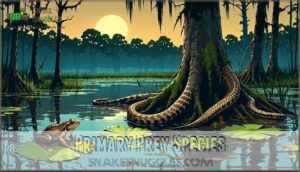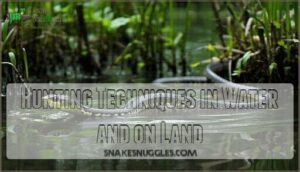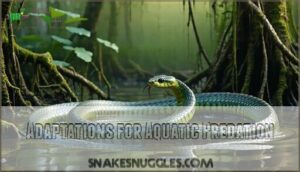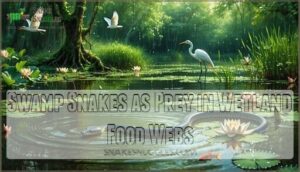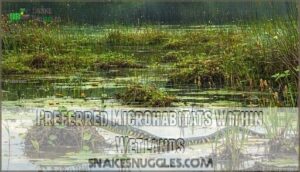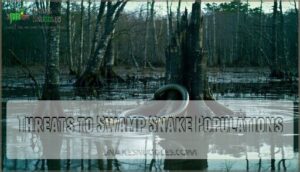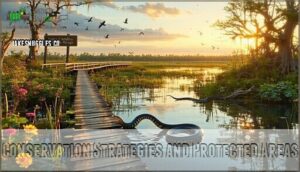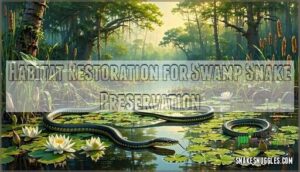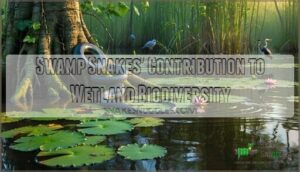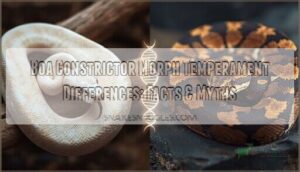This site is supported by our readers. We may earn a commission, at no cost to you, if you purchase through links.
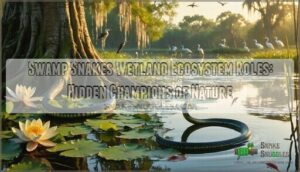
These aquatic serpents serve as both efficient predators and essential prey, creating a ripple effect throughout wetland food webs. They control amphibian and small fish populations while providing pivotal nutrition for birds, mammals, and larger reptiles.
Think of them as wetland "middle management" – they keep smaller populations in check while feeding the bigger players above them. Their presence indicates healthy water quality and diverse habitat conditions.
From cottonmouths to water snakes, each species fills specific ecological niches that support overall biodiversity. Understanding their complex relationships reveals surprising strategies these serpents use to thrive.
Table Of Contents
- Key Takeaways
- Swamp Snakes: Key Players in Wetland Ecosystems
- Predatory Roles of Swamp Snakes
- Swamp Snakes as Prey in Wetland Food Webs
- Habitat Requirements and Conservation of Swamp Snakes
- Swamp Snakes’ Contribution to Wetland Biodiversity
- Frequently Asked Questions (FAQs)
- Are snakes a wetland animal?
- What are the major roles that wetlands play?
- Why do snakes live in swamps?
- How do swamp snakes survive the winter?
- Are there any venomous swamp snakes?
- Whats the difference between a swamp snake and a water snake?
- Can you find swamp snakes outside of wetlands?
- How do swamp snakes hunt?
- How do swamp snakes reproduce and breed?
- What lifespan do different swamp snake species have?
- Conclusion
Key Takeaways
- You’ll discover that swamp snakes function as "middle management" in wetland food webs, controlling amphibian and fish populations while providing essential nutrition for larger predators like birds and alligators.
- You can use swamp snakes as living indicators of wetland health since they’re highly sensitive to water quality changes, pollution levels, and habitat degradation – their presence signals a thriving ecosystem.
- You’ll find that swamp snakes serve as nature’s pest control specialists, effectively regulating rodent populations that would otherwise damage aquatic vegetation and disrupt ecosystem balance.
- You should recognize that protecting swamp snakes is crucial for wetland conservation since they support biodiversity, maintain genetic diversity, and contribute to successful habitat restoration projects through their ecological roles.
Swamp Snakes: Key Players in Wetland Ecosystems
You’ll discover how swamp snakes have mastered wetland living through remarkable adaptations that make them perfectly suited for their watery world.
These serpentine specialists occupy diverse ecological niches, from lurking in murky waters to basking on fallen logs, creating intricate relationships with other wetland species that keep these ecosystems balanced and thriving, showcasing their ability to live in a watery world and maintain ecological niches.
Slithering guardians of wetlands, weaving life’s delicate balance beneath cypress shadows and cattail whispers.
Species Diversity in Swamp Habitats
When exploring swamp habitats, you’ll discover remarkable species diversity among these serpentine residents. Each species has carved out its own niche in the wetland ecosystem, contributing to overall ecosystem balance.
Here are four key groups you’ll encounter:
- Water moccasins – Venomous snakes patrolling murky waters
- Garter snakes – Masters of vernal pool hunting techniques
- Rainbow snakes – Specialists consuming eels exclusively
- Green water snakes – Expert baskers on fallen logs
This wetland biodiversity includes both endemic snakes and occasional invasive species. Species identification becomes essential for understanding which are venomous snakes versus harmless varieties. Some rare species remain hidden in these biodiverse hotspots.
Effective biodiversity surveys are essential for conservation efforts in these ecosystems.
Adaptations for Aquatic Environments
Swamp snakes possess remarkable aquatic adaptations that make them wetland ecosystem champions.
Their streamlined bodies and waterproof scales enable effortless aquatic locomotion through murky waters.
These serpents have evolved specialized breathing techniques for extended underwater hunts, while enhanced underwater vision helps them navigate dense vegetation.
Their pressure-sensitive organs detect prey movements in aquatic habitats perfectly.
Ecological Niches of Swamp Snakes
Different swamp snakes occupy specialized ecological niches across wetland ecosystems.
These adaptable reptiles demonstrate remarkable species diversity by filling distinct roles within aquatic habitats.
Their strategic positioning maintains ecosystem balance through targeted predation and resource utilization.
Key ecological niches include:
- Benthic hunters – Water moccasins patrol murky depths, controlling amphibian populations
- Surface specialists – Green water snakes bask on logs while monitoring prey movement
- Vegetation dwellers – Garter snakes navigate dense cattails and emergent plants
- Eel specialists – Rainbow snakes target specific prey in deeper wetland channels
Each species’ unique snake behavior patterns contribute essential ecosystem services, from pest control to nutrient cycling, supporting overall wetland ecology through their aquatic adaptations.
Interactions With Other Wetland Species
In wetlands, you’ll witness intricate species interactions that define ecosystem balance.
Swamp snakes compete with wading birds, turtles, and fish for amphibian prey, creating dynamic predator prey relationships.
These interactions shape wetland dynamics and support biodiversity conservation through complex food web dynamics.
| Interaction Type | Species Involved | Ecosystem Impact |
|---|---|---|
| Competition | Snakes vs. Herons | Resource partitioning |
| Predation | Snakes consume frogs | Population control |
| Mutualism | Snakes clean parasites | Health maintenance |
| Habitat sharing | Multiple predators | Niche diversification |
Seasonal Behavior Patterns
Winter dormancy defines how swamp snakes survive cold months through reduced metabolism and hibernation.
When temperatures drop, these reptiles seek shelter in muddy banks or underwater crevices.
Their seasonal behavior directly impacts wetland ecosystem dynamics through varying predation pressure and breeding cycles throughout the year.
- Winter Dormancy: Snakes enter brumation in muddy banks or submerged logs
- Breeding Cycles: Spring emergence triggers intensive mating behaviors and territorial displays
- Migration Routes: Seasonal habitat shifts between deep water refuges and shallow feeding areas
- Food Scarcity: Late fall drives aggressive foraging before winter energy conservation
- Habitat Shifts: Water level changes force movement between permanent and temporary wetland zones
Predatory Roles of Swamp Snakes
You’ll discover that swamp snakes act as nature’s pest control experts, hunting everything from amphibians to fish with remarkable precision.
These skilled predators use specialized techniques both above and below water, keeping wetland ecosystems balanced through their hunting prowess.
Primary Prey Species
These aquatic predators target numerous wetland species.
They primarily consume amphibian species like frogs and salamanders, while also hunting fish populations in shallow waters.
Their diet includes invertebrate prey such as crayfish and aquatic insects found in muddy substrates.
Some species occasionally capture small mammals and wetland birds near shorelines.
Understanding aquatic snake prey is essential for analyzing the complex food webs involving snake feeding habits.
| Prey Category | Common Species |
|---|---|
| Amphibians | Frogs, salamanders |
| Fish | Minnows, small catfish |
| Invertebrates | Crayfish, aquatic insects |
Hunting Techniques in Water and on Land
These skilled ambush tactics make swamp snakes incredibly effective aquatic predators.
Water hunting involves using side-stroke locomotion to glide silently through murky waters, while land predation relies on snake camouflage near water’s edge.
Their hunting techniques showcase remarkable prey capture abilities, combining patience with lightning-fast strikes that demonstrate sophisticated predator-prey dynamics.
Impact on Prey Population Dynamics
Nature’s balance hangs on predator-prey relationships, and swamp snakes excel at maintaining ecosystem balance. These aquatic hunters demonstrate remarkable prey regulation, with densities reaching 1,287 individuals per hectare in Florida wetlands.
Here’s how swamp snakes impact population control:
- Predator-prey relationships reduce amphibian and invertebrate abundance during post-drought recovery periods
- Dynamic stability emerges as snakes selectively target abundant prey species like crayfish and frogs
- Population trends show direct correlation between snake density and controlled prey numbers
- Species diversity increases when snake predation prevents any single prey group from dominating
Understanding the role of water depth management is vital for maintaining a healthy ecosystem.
Importance in Controlling Pest Species
Swamp snakes function as wetland ecosystem’s unsung pest control specialists.
These serpentine specialists are nature’s unsung heroes, silently keeping wetland ecosystems in perfect balance.
You’ll find they’re remarkably effective at regulating rodent populations that would otherwise devastate aquatic vegetation.
Their predation maintains critical population balance, preventing ecological disruption while supporting biodiversity conservation.
| Pest Species | Snake Predation Impact | Ecosystem Health Benefit |
|---|---|---|
| Marsh rats | 60-80% population control | Protects root systems |
| Voles | Reduces crop damage by 45% | Maintains plant diversity |
| Invasive rodents | Controls breeding cycles | Preserves native species |
| Aquatic insects | Balances larval populations | Supports water quality |
Adaptations for Aquatic Predation
Beyond controlling pests, swamp snakes showcase remarkable aquatic hunting adaptations that make them formidable predators.
These aquatic species have evolved specialized features for underwater success:
- Aquatic Vision – Enhanced underwater sight for spotting prey in murky water
- Snake Camouflage – Coloration patterns that blend seamlessly with swamp habitats
- Water Resistance – Streamlined bodies with waterproof scales for efficient movement
Their Prey Detection systems include pressure-sensitive organs that sense vibrations, while flexible jaws enable Hunting Tactics like swallowing fish whole underwater.
Swamp Snakes as Prey in Wetland Food Webs
While you might think of swamp snakes as fearsome predators, they’re equally important as prey in wetland food webs.
These aquatic serpents support entire communities of birds, mammals, and fish that depend on them for survival, creating a key link in nature’s complex energy transfer system, which is a crucial aspect of complete ecosystems.
Natural Predators of Swamp Snakes
Aquatic predators create constant danger for swamp snakes in wetland food webs.
Bird Predators like herons and hawks strike from above, while Large Fish such as bass ambush from below.
Alligator Predation poses the greatest threat in deeper waters.
Otter Attacks target smaller species, and Raccoon Threats emerge during nocturnal hunting.
These predator-prey relationships shape food web dynamics throughout wetland ecosystems.
Understanding the role of snake eating species is essential in maintaining the balance of these ecosystems.
Defensive Mechanisms and Behaviors
Clever snakes employ sophisticated strategies when threatened by predators.
These wetland survivors have mastered survival through specialized defensive mechanisms that showcase remarkable snake behavior in predator-prey relationships.
- Camouflage Tactics: Blending seamlessly with murky water and vegetation
- Warning Signals: Displaying vibrant colors or aggressive posturing
- Escape Strategies: Lightning-fast retreats into dense aquatic cover
Despite habitat loss pressures, their camouflage remains their strongest defense.
Role in Supporting Higher Trophic Levels
When you look at wetland food webs, swamp snakes become vital energy sources for numerous predators.
These serpents support biodiversity conservation by serving as nutritious prey for birds like herons and egrets, which depend on them during breeding seasons.
Alligators consume larger specimens, while king snakes regulate populations through predator-prey relationships.
The trophic support they provide maintains ecosystem balance across multiple levels.
| Predator | Prey (Swamp Snakes) | Energy Transfer |
|---|---|---|
| Birds (herons, egrets) | Adult swamp snakes | Supports bird populations |
| Alligators | Large swamp snakes | Maintains alligator health |
| Larger snakes (king snakes) | Small to medium swamp snakes | Regulates snake populations |
| Otters | Swamp snake eggs and juveniles | Impacts otter survival |
| Fish (large predatory fish) | Swamp snake hatchlings | Influences fish populations |
Importance for Migratory Bird Species
Swamp snakes play a pivotal role in supporting migratory birds through complex predator-prey relationships within wetland ecosystems.
These interactions directly influence bird migration success and wetland conservation efforts.
- Avian predation by great blue herons and egrets helps control snake populations while providing essential nutrition during migration stopovers
- Dense vegetation creates natural barriers that reduce snake access to bird nests, supporting ecosystem balance through habitat complexity
- Species interactions between snakes and birds maintain species diversity by preventing any single predator from dominating wetland food webs
Energy Transfer Within Wetland Ecosystems
When birds migrate through wetlands, they’re not just passing through – they’re plugging into nature’s energy transfer network.
Swamp snakes convert nutrients from amphibians and fish into accessible protein packages that fuel these travelers.
This food web connection transforms local nutrient cycling into continental energy highways.
Through trophic levels, snakes bridge aquatic and terrestrial ecosystem balance, supporting species diversity across vast migration corridors.
Habitat Requirements and Conservation of Swamp Snakes
You’ll find that swamp snakes require specific conditions within wetlands to thrive, including dense aquatic vegetation, clean water, and diverse microhabitats for shelter and hunting.
Unfortunately, these remarkable creatures face mounting threats from habitat destruction, pollution, and climate change, making conservation efforts more critical than ever for preserving both the snakes and the wetland ecosystems they help maintain.
Preferred Microhabitats Within Wetlands
Finding the perfect home isn’t just about location—it’s about creating the right conditions for survival and reproduction. Swamp snakes have evolved specific habitat requirements that make certain wetland areas irresistible sanctuaries.
These reptiles thrive in wetland habitats where multiple environmental factors align perfectly. Their ecosystem balance depends on finding microhabitats with precise characteristics that support both hunting success and protection from predators.
Critical microhabitat features include:
- Aquatic Plants diversity – Dense vegetation provides hunting grounds and shelter, with emergent, submerged, and floating plants creating a three-dimensional habitat structure
- Water Depth zones – Shallow areas (1-4 feet) allow effective hunting while deeper sections offer escape routes and temperature regulation
- Wetland Soils composition – Mixed substrates of mud, sand, and organic matter support diverse prey populations and provide burrowing opportunities
- Microclimate stability – Temperature gradients between 64-90°F create thermal refugia where snakes can regulate body temperature efficiently
Vegetation Density plays a vital role in determining habitat quality, as swamp snakes require balanced coverage that provides protection without restricting movement through their wetland ecosystem home.
Threats to Swamp Snake Populations
While preferred wetland microhabitats provide shelter, habitat loss through wetland drainage devastates swamp snake populations.
Climate change alters temperature patterns, disrupting breeding cycles.
Pollution effects from heavy metals and pesticides cause organ damage and reduced lifespans.
Human persecution from fear leads to intentional killing.
Disease outbreaks from invasive species introduce novel parasites, threatening survival rates across wetland ecosystems.
Conservation Strategies and Protected Areas
Within protected wetlands, you’ll find thorough species protection through legal frameworks and ecosystem management.
These conservation strategies combine federal legislation with state-level habitat preservation initiatives to safeguard swamp snake populations.
Effective conservation also relies on successful wetland restoration techniques.
Key conservation approaches include:
- Wetland restoration programs that rebuild degraded aquatic habitats
- Protected areas designation through national wildlife refuges and state parks
- Species preservation monitoring through population tracking and research initiatives
Habitat Restoration for Swamp Snake Preservation
Wetland restoration efforts create essential lifelines for swamp snake populations through strategic Habitat Engineering and Wetland Renewal projects.
You’ll find Snake Sanctuaries emerging from carefully planned habitat restoration initiatives that restore native vegetation and water flow patterns.
These Biodiversity Conservation efforts provide essential Ecosystem Services, supporting the intricate wetland ecosystem while allowing swamp snakes to fulfill their critical ecosystem roles in conservation biology.
Effective wetland restoration techniques are important for maintaining healthy swamp snake habitats.
Monitoring and Research Initiatives
You’ll sharpen your conservation game by tracking these slippery ecosystem champions through cutting-edge research methods.
Modern snake research combines high-tech tools with boots-on-the-ground fieldwork to protect wetland biodiversity.
- PIT telemetry and GPS tracking – Track individual snakes through murky waters with pinpoint accuracy
- Mark-recapture studies and isotope analysis – Reveal population density and dietary secrets hidden beneath the surface
- Automated sensor stations – Monitor water levels, temperature, and habitat conditions around the clock
Data analysis transforms raw numbers into conservation action plans, while species tracking helps researchers understand movement patterns and survival rates in threatened wetlands.
Understanding snake habitat diversity is essential for developing effective conservation strategies that address the complex needs of swamp snakes in various ecosystems.
Swamp Snakes’ Contribution to Wetland Biodiversity
You’ll discover that swamp snakes aren’t just residents of wetlands—they’re essential architects of biodiversity.
These aquatic specialists maintain genetic richness within their populations while serving as living thermometers for ecosystem health, making them invaluable partners in conservation efforts.
Genetic Diversity Within Snake Populations
Examining genetic diversity within swamp snake populations reveals fascinating heredity patterns that shape their survival.
Northern populations show 30-40% less genetic variation than southern ones due to habitat fragmentation.
This reduced gene flow creates serious consequences for snake evolution.
| Population Factor | Impact on Diversity |
|---|---|
| Habitat Size | Larger areas maintain higher genetic variation |
| Isolation Level | Fragmented populations lose adaptive capacity |
| Urban Barriers | Rivers and development restrict gene flow |
Population genetics studies demonstrate how ecological niche specialization drives genetic adaptation.
When effective population sizes drop below 100 individuals, inbreeding depression threatens long-term viability.
Species diversity depends on maintaining connectivity between wetland habitats to preserve essential genetic variation for future environmental challenges.
Indicator Species for Wetland Health
You’ll find swamp snakes are nature’s living barometers for wetland ecosystem health.
These indicator species respond quickly to environmental changes, making them perfect for Wetland Monitoring programs. Their sensitivity reveals problems before they’re visible.
- Water quality shifts trigger immediate population changes in snake communities
- Habitat degradation reduces breeding success and Species Conservation outcomes
- Pollution levels directly impact snake health and Biodiversity Indicators
Scientists track these patterns to assess Habitat Quality and maintain ecological balance effectively.
Role in Maintaining Ecosystem Balance
You’ve learned how swamp snakes signal wetland health—now see how they maintain ecosystem balance.
These serpents orchestrate complex species interactions through predator-prey relationships that stabilize wetland ecosystems. By controlling amphibian and rodent populations, they prevent overgrazing and support species diversity.
Their ecological niche creates ripple effects throughout the wetland ecosystem, enhancing biodiversity conservation efforts. This delicate balance maintains wetland health remains intact.
Ecological Balance Factors Swamp Snake Symbiosis Impact
Importance in Wetland Restoration Projects
Why wouldn’t you want swamp snakes as your restoration allies? These serpentine partners transform wetland restoration projects into thriving ecosystems through their ecological expertise.
When planning habitat restoration, consider how swamp snakes enhance your conservation efforts:
- Pest population control – Natural regulation of rodent and insect communities
- Biodiversity management indicators – Early warning systems for ecosystem health
- Ecosystem services enhancement – Supporting pollinator and amphibian populations
- Habitat preservation motivation – Flagship species inspiring community engagement
- Restoration ecology validation – Proof your wetland ecosystem is functioning properly
- Food web stability – Connecting aquatic and terrestrial habitat zones
- Water quality improvement – Controlling species that disrupt aquatic balance
- Long-term sustainability – Self-maintaining ecological balance reduces management costs
Their presence signals successful wetland conservation, making restoration projects more resilient and effective.
By creating a snake friendly environment, you can promote ecosystem balance and support the essential role of swamp snakes in wetland ecosystems.
Cultural and Educational Significance
You’ll discover that swamp snakes carry deep cultural significance across many societies.
Native American traditions often revere these serpents as rainfall spirits, while serpent symbolism appears in creation myths worldwide.
Modern Snake Conservation efforts leverage this fascination through Eco Tourism and Educational Outreach programs.
Wetland Education initiatives use snakes as charismatic ambassadors, boosting Public Awareness about ecosystem health.
Snake Research projects engage citizen scientists, transforming fear into fascination.
These Conservation Education approaches prove that understanding cultural connections enhances Environmental Awareness and protection efforts.
Frequently Asked Questions (FAQs)
Are snakes a wetland animal?
Many snakes thrive in wetlands! You’ll find species like water moccasins, garter snakes, and green water snakes perfectly adapted to these aquatic environments, making wetlands their natural home.
What are the major roles that wetlands play?
Like nature’s kidneys filtering toxins from your body, wetlands purify water by trapping sediments and absorbing pollutants. They’re flood buffers, wildlife nurseries, and carbon storage vaults that protect you.
Why do snakes live in swamps?
Snakes choose swamps because you’ll find abundant prey like frogs, fish, and small mammals there.
The warm, humid environment suits their cold-blooded nature, while dense vegetation provides perfect camouflage and protection.
How do swamp snakes survive the winter?
Did you know 70% of snake species become less active during winter months?
When temperatures drop, you’ll find swamp snakes entering brumation—a reptilian version of hibernation.
They’ll burrow into mud, hollow logs, or underground dens, slowing their metabolism dramatically to survive cold months with minimal energy, using a state similar to hibernation.
Are there any venomous swamp snakes?
Yes, you’ll encounter venomous swamp snakes! The cottonmouth (water moccasin) packs potent venom and thrives in southeastern swamps. They’re surprisingly defensive, displaying their white mouths before striking.
Whats the difference between a swamp snake and a water snake?
Absolutely mind-blowing how confused people get!
You’ll find "swamp snake" describes any snake living in wetlands, while "water snake" specifically refers to semi-aquatic species that hunt and swim actively in water.
Can you find swamp snakes outside of wetlands?
You’ll occasionally spot them venturing beyond their wetland homes, especially during heavy rains or droughts when they’re searching for better conditions or prey opportunities nearby.
How do swamp snakes hunt?
Like Victorian naturalists wielding magnifying glasses, you’ll observe swamp snakes employing ambush tactics in murky waters.
They lurk motionlessly, using pressure-sensitive organs and flexible jaws to detect and constrict prey like amphibians, fish, and invertebrates through patient underwater hunting.
How do swamp snakes reproduce and breed?
Swamp snakes reproduce through internal fertilization, with males using specialized organs called hemipenes. You’ll find females laying eggs in moist vegetation or giving birth to live young, depending on species.
What lifespan do different swamp snake species have?
Time flies when you’re studying snake lifespans! You’ll find water moccasins typically live 10-15 years, while smaller species like black swamp snakes reach 5-8 years in wild conditions.
Conclusion
Slithering silently through wetland waters, these serpentine sentinels demonstrate that swamp snakes’ wetland ecosystem roles extend far beyond simple predation.
You’ve discovered how they maintain ecological balance as nature’s middle management, controlling prey populations while feeding larger predators.
Their presence signals healthy wetland conditions and supports biodiversity conservation efforts.
By protecting these aquatic ambassadors, you’re preserving entire wetland communities for future generations.
- https://digitalcommons.usf.edu/cgi/viewcontent.cgi?article=1269&context=ffn
- https://www.bayouswamptours.com/blog/swamp-predators/
- https://www.dnr.sc.gov/wildlife/wetlands/ClemsonExtension-WetlandEcology.pdf
- https://www.herpconbio.org/Volume_19/Issue_2/Rowe_etal_2024.pdf
- https://www.ebsco.com/research-starters/earth-and-atmospheric-sciences/animal-life-swamps-and-marshes

